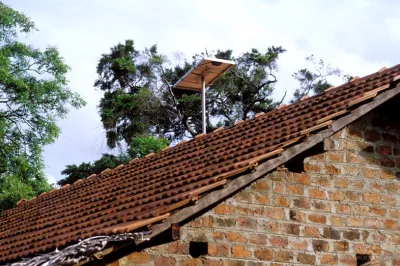Are PAYGo Solar Companies a New Type of Microfinance Institution?

Pay-as-you-go (PAYGo) solar companies have been lauded, by CGAP and others, for their ability to provide low-income rural households with clean, affordable energy. Yet there are many unanswered questions about their business models that may limit the speed and scope of their growth. Much of the confusion stems from the fact that the leading companies in the space are engaged in a wide variety of activities, from design and manufacturing to consumer financing. Given the diversity of PAYGo companies’ activities, it is fair to ask: Are they energy service companies, durable goods retailers or microfinance institutions (MFIs)? There is probably not a simple answer, and different companies may pursue different paths, but acknowledging PAYGo companies’ similarities to MFIs could help this emerging sector learn from MFIs’ experiences and overcome some key challenges.
A shift in perspective: PAYGo solar as microleasing
The leading PAYGo solar companies set out to solve an energy access problem, but because of the relatively low incomes of their customers and the relatively high cost of their products, their business models require a solution with an embedded financial product. And embedding a financial product has required these companies to build out activities that are similar to what MFIs have been doing for years.
“We see ourselves as an energy service company, but we understand the importance of having a strong credit department. That’s why we’re increasing our investments into credit scoring and understanding customer finances — for example, how crop cycles affect cash flows and how our offerings should take those cash flows into account.”
— Paul Warnars, Consumer and Market Intelligence Manager, Off Grid Electric
We could even take this logic one step further and say that some companies could develop the financial institution side of their business as a core competency. A PAYGo solar company with a strong credit department could use the knowledge of its customer's risk profile, payment behavior, and desires to build a suite of leasing and other financial products.
Even if most PAYGo companies never get this far, the financial inclusion implications of the financial products they already offer are exciting. We have anecdotal evidence that more than half of new PAYGo customers do not have a relationship with a financial institution, which means that PAYGo companies have created a business model that provides financing to rural, low-income customers that even traditional MFIs have been unable to reach.
Lessons from the microfinance sector: A robust funding ecosystem
Each PAYGo company will have to decide how much to focus on its financial activities, but all of them share at least some similarities with MFIs in terms of target customers, the sizes of the loans they are making to customers, balance sheet management, and their potential for development impact. Given these similarities, PAYGo companies, investors, and development professionals can look to the more mature MFI market for lessons to apply to the rapidly evolving PAYGo solar market.
One important set of lessons relates to the ecosystem of players that has evolved to help support the growth and sustainability of the microfinance sector. The MFI ecosystem includes a variety of actors, from core banking system providers (e.g., Oradian) to data aggregators (e.g., MIX Market), to customer protection standard setters (e.g., Smart Campaign), each of which could add value to the PAYGo solar space. In some cases, the same players will be able to adapt their services to meet the needs of both the PAYGo solar and MFI sectors. In other cases, new, more specialized players will need to emerge, but they can build off of the business models that are already established in the MFI space, rather than starting from scratch. Here we focus on players that address what has long been a critical challenge for the MFI sector — particularly during its early stages — and is now challenging PAYGo companies: attracting and managing funding.
Debt funders
If you have been paying attention to the PAYGo sector, you have probably come across the recent series of articles posted on Next Billion — by Ceniarth, Persistent Energy, GOGLA, and IFC — that discuss the level of investment flows into the sector. A related issue is the type of investment flows. We have said in the past that an integrated approach is best, and that massive amounts of wholesale debt will be required to finance the working capital of the sector. As noted, managing that debt is an activity that MFIs have been doing for decades and that PAYGo companies will need to master.
“The treasury department of a PAYGo company needs to have the same skills as one in a financial institution. It has to match the asset and liability sides of the balance sheet in terms of duration and [foreign exchange]. It has to consider its liabilities [debt] when designing assets [loans, leases, solar home systems] and vice versa.”
— Chad Larson, Founder/Finance Director, MKOPA
Finding debt providers has also been a challenge, which was also true in the early days of microfinance. Over time, microfinance investment vehicles (MIVs) developed an expertise in the unique business of providing wholesale debt to MFIs in the developing world, and it would not be a departure for them to do the same for PAYGo solar companies. MIVs collectively manage over $10 billion of funds dedicated mainly to microfinance investments and, as they look for new opportunities, many have become interested in the PAYGo solar market.
“We have built strong renewable energy capabilities, which led us to raise our Energy Access Fund two years ago, and we’re excited about the opportunities we see in this sector. However, some PAYGo solar companies have similar characteristics as asset-backed financing companies, and those investments could fit into our MFI portfolios as well."
— Martin Heimes, Head of Financial Institution Debt Financing, ResponsAbility
Foreign exchange hedging services
Most international investors have hard currency funds, but taking a loan in a hard currency when your customers are earning in a local currency creates a mismatch that can put companies and their borrowers at risk of default. Here, too, the MFI ecosystem has already achieved some scale in providing solutions. Players like TCX and MFX have been providing currency hedging solutions to development finance institutions and MIVs for the past 10 years. And new entrants like Frontera Capital are looking to provide similar solutions. The products they provide should be easy to replicate in the PAYGo solar space, particularly for shorter tenor transactions.
“We have engaged with several of our current and potential clients about currency risk hedging in the PAYGo sector and see this as a promising area of growth for our business. That and the broader off-grid and clean energy space.”
— Luz Leyva, MFX Solutions, Senior Trader
What’s next?
PAYGo solar companies can represent different things to different people. They have received a lot of attention from the donors, investors, and development actors focused on energy access, and with good reason. Their impact on energy access has been impressive. As the companies evolve, however, the financial sector activities they are involved in have taken on a larger role in their business models. Consequently, these companies now show significant potential to drive financial inclusion. At CGAP, we are continuing to work on untangling the value chains the companies are involved in and are asking the question: What comes next?




Comments
Any kind of financing what
Any kind of financing what ever named, that is not linked to income generating value chain cannot be ethically called microfinace and in the same vein, financing institutions need not be baptised as MFI.
The goods like water,energy, gas, road. Communication. Transport etc. Should be taken care of by government as public services for the poor and not to thrust as financial products for promoting MFI in the supply side as it ultimately puts the poor in debt trap in the demand side.
Policy makers and MFI experts need to think twice in this regard instead of making tall claim on anecdotal cases
Dr. V. Rengarajan: Thank you
Dr. V. Rengarajan: Thank you for your comments. You raise several interesting points and I’d like to address them one by one.
I agree that, in a perfect world, governments should provide low-income people with high quality basic services like education, energy and water. But in the world we live in, many governments are struggling to do so. The reality is most PAYGo customers is that they either get their electricity from these companies or they don’t get any electricity at all. Which is the worse outcome? Governments should continue to strive to improve the lives of their citizens through public services, but there is a role for others to fill the gap until that happens.
I also agree that there’s a risk of customers borrowing beyond their means and falling into a debt trap. But that’s not any different from traditional microfinance. Customer protection standards need to be put in place to minimize these risks, which is why I allude to the idea that we need a “Smart Campaign” for these types of products.
What I do not agree with are the propositions that consumer financing is somehow inherently unethical or that lending for productive purposes is somehow inherently ethical. By and large, I am of the view that traditional microfinance has a positive impact on the lives of the poor, but the sector has certainly witnessed its share of unethical practices. As for consumer lending, as Amartya Sen showed us, development is not just about income. In the PAYGo space specifically, customers’ lives are improved by having access to electricity in a number of ways that have nothing to do with their incomes. I suggest you read Julie Zollmann’s recent blog post “Stuff Matters” for a more detailed argument.
We’ve touched on a number of controversial topics here. This is an important conversation and one that I think we should continue having. But I should note that the views I’ve expressed in my response here are my own and not necessarily those of CGAP.
Add new comment